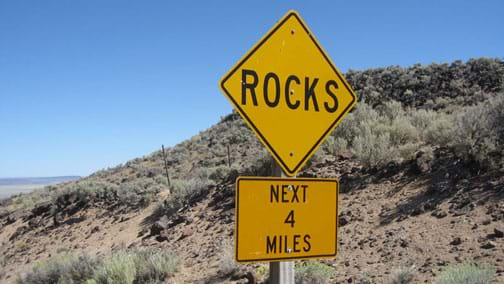
Summary
Through five lessons, students are introduced to all facets of the rock cycle. Topics include rock and mineral types, material stresses and weathering, geologic time and fossil formation, the Earth's crust and tectonic plates, and soil formation and composition. Lessons are presented in the context of the related impact on humans in the form of roadway and tunnel design and construction, natural disasters, environmental site assessment for building structures, and measurement instrumentation and tools. Hands-on activities include experiencing tensional, compressional and shear material stress by using only hand force to break bars of soap; preparing Jeopardy-type trivia questions/answers for a class game that reinforces students' understanding of rocks and the rock cycle; creating "fossils" using melted chocolate; working within design constraints to design and build a model tunnel through a clay mountain; and soil sampling by creating tools, obtaining soil cores, documenting a soil profile log, and analyzing the findings to make engineering predictions.Engineering Connection
Engineers learn about the natural world in order to design the human-built environment. Rocks, soils, fossils and the Earth's crust make up the foundation of the world we depend upon. Engineers must understand the characteristics of these rocks and materials so that they can design big infrastructure projects—such as bridges, foundations, roads and tunnels—to be safe and long-lasting. Geotechnical engineers apply their understanding of rocks to environmental site investigations for the purposes of land development and environmental stewardship. To prevent and limit the destruction of communities and human life, engineers also develop technologies to assess and predict natural hazards caused by rock movement. Engineers apply their understanding of science and math to designing the tools and instrumentation for sampling, sensing, drilling, boring, analyzing and modeling—so we can learn more and predict better.
Unit Overview
Lesson 1 - Rock Solid: An introduction to the types of rocks and minerals, as well as material stresses and weathering
Lesson 2 - Making & Breaking: How natural weathering, erosion, pressure and heat are part of the rock cycle
Lesson 3 - Fantastic Fossils: Geoologic time and fossil formation
Lesson 4 - How Mountains Are Formed: The Earth's crust and tectonic plates as they impact roadways, tunnels, natural resource location and natural disaster prediction
Lesson 5 - Soil Investigations: Soil formation, composition and properties as seen in soil profiles and soil sampling for environmental site assessment
Educational Standards
Each TeachEngineering lesson or activity is correlated to one or more K-12 science,
technology, engineering or math (STEM) educational standards.
All 100,000+ K-12 STEM standards covered in TeachEngineering are collected, maintained and packaged by the Achievement Standards Network (ASN),
a project of D2L (www.achievementstandards.org).
In the ASN, standards are hierarchically structured: first by source; e.g., by state; within source by type; e.g., science or mathematics;
within type by subtype, then by grade, etc.
Each TeachEngineering lesson or activity is correlated to one or more K-12 science, technology, engineering or math (STEM) educational standards.
All 100,000+ K-12 STEM standards covered in TeachEngineering are collected, maintained and packaged by the Achievement Standards Network (ASN), a project of D2L (www.achievementstandards.org).
In the ASN, standards are hierarchically structured: first by source; e.g., by state; within source by type; e.g., science or mathematics; within type by subtype, then by grade, etc.
See individual lessons and activities for standards alignment.
Subscribe
Get the inside scoop on all things TeachEngineering such as new site features, curriculum updates, video releases, and more by signing up for our newsletter!Unit Schedule
- Day 1: Rock Solid lesson
- Day 2: Soapy Stress activity
- Day 3: Rocks, Rocks, Rocks activity
- Day 4: Making & Breaking: The Rock Cycle lesson
- Day 5: Rock Jeopardy! activity
- Day 6: Fantastic Fossils lesson and Fossil Fondue activity
- Day 7: Fossil Fondue activity
- Day 8: How Mountains are Formed lesson and Tunnel Through! activity
- Day 9: Tunnel Through! activity
- Day 10: Soil Investigations lesson
- Day 11: Soil Core Sampling activity
More Curriculum Like This

Students are introduced to three types of material stress related to rocks: compressional, torsional and shear. They learn about rock types (sedimentary, igneous and metamorphic), and about the occurrence of stresses and weathering in nature, including physical, chemical and biological weathering.

Students investigate how mountains are formed. Students learn that geotechnical engineers design technologies to measure movement of tectonic plates and mountain formation, as well as design to alter the mountain environment to create safe and dependable roadways and tunnels.

Students learn the basics about soil, including its formation through the cycling of the Earth's materials, as well as its characteristics and importance. They are also introduced to soil profiles and how engineers conduct site investigations to learn about soil quality for development, contaminatio...

Students learn about major landforms (such as mountains, rivers, plains, valleys, canyons and plateaus) and how they occur on the Earth's surface. They learn about the civil and geotechnical engineering applications of geology and landforms, including the design of transportation systems, mining, ma...
Copyright
© 2008 by Regents of the University of ColoradoContributors
See individual lessons and activities.Supporting Program
Integrated Teaching and Learning Program, College of Engineering and Applied Science, University of Colorado BoulderAcknowledgements
This digital library content was developed by the Integrated Teaching and Learning Program under National Science Foundation GK-12 grant no. 0338326. However, these contents do not necessarily represent the policies of the National Science Foundation, and you should not assume endorsement by the federal government.
Last modified: August 22, 2017







User Comments & Tips